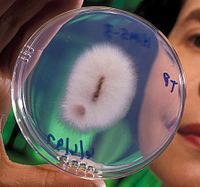
Photo from wikipedia
Abstract A field survey was conducted to determine the distribution and association of biophysical factors with chickpea Fusarium wilt (CFW), and to characterize CFW isolates from Northern Shoa, Ethiopia, in… Click to show full abstract
Abstract A field survey was conducted to determine the distribution and association of biophysical factors with chickpea Fusarium wilt (CFW), and to characterize CFW isolates from Northern Shoa, Ethiopia, in 2018/19. A total of 63 fields were inspected from major chickpea growing districts, and found 100% prevalence. Wilt incidence and severity were variable (34.3–50.2%) across districts. Logistic regression was used to analyze association of CFW with biophysical factors. High (>40%) incidence and severity were strongly associated with district, grey soil, pod setting, low to medium plant population, and dry soil moisture condition. Twenty six Fusarium oxysporum f.sp. ciceris isolates were identified and were highly variable in colony texture, sporulation capacity, conidial shape and size, septation character, and chlamydospore types. Most of the isolates were highly pathogenic, causing ≥50% wilting. It is confirmed that CFW is important and the pathogen is highly variable, implying for designing of effective management options.
Journal Title: Archives of Phytopathology and Plant Protection
Year Published: 2021
Link to full text (if available)
Share on Social Media: Sign Up to like & get
recommendations!